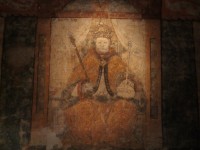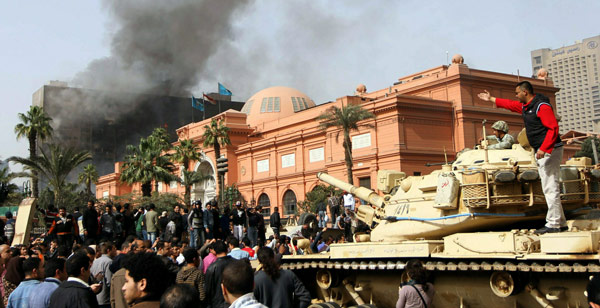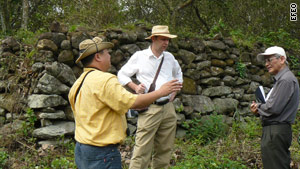On Friday, January 28, 2011, when the protest marches began in Cairo, I heard that a curfew had been issued that started at 6.00pm on Friday evening until 7.00am on Saturday morning. Unfortunately, on that day the Egyptian Museum, Cairo, was not well guarded. About a thousand people began to jump over the wall on the eastern side of the museum into the courtyard. On the western side of the museum, we recently finished something I was very proud of, a beautiful gift shop, restaurant and cafeteria. The people entered the gift shop and stole all the jewellery and escaped; they thought the shop was the museum, thank God! However, ten people entered the museum when they found the fire exit stairs located at the back of it.
As every one knows, the Egyptian Museum, Cairo, is naturally lit and due to the architectural style of it, there are glass windows on its roof. The criminals broke the glass windows and used ropes to get inside, there is a distance of four metres from the ceiling to the ground of the museum. The ten people broke in when I was at home and, although I desperately wanted to go to the museum, I could not leave my house due to the curfew. In the morning, as soon as I woke up, I went directly there. When I arrived, I found out that, the night before, three tourist police officers had stayed there overnight because they were not able to get out before the curfew was put in place. These officers, and many young Egyptians who were also there, helped to stop more people from entering the museum. Thankfully, at 10.00pm on Friday night, the army arrived at the museum and gave additional security assistance.
I found out that one criminal was still at the museum, too. When he had asked the people guarding the museum for water, they took his hands and tied him to the door that lead to the gift shop so that he could not escape! Luckily, the criminals who stole the jewellery from the gift shop did not know where the jewellery inside the museum is kept. They went into the Late Period gallery but, when they found no gold, they broke thirteen vitrines and threw the antiquities on the floor. Then the criminals went to the King Tutankhamun galleries. Thank God they opened only one case! The criminals found a statue of the king on a panther, broke it, and threw it on the floor. I am very thankful that all of the antiquities that were damaged in the museum can be restored, and the tourist police caught all of the criminals that broke into it. On Saturday, the army secured the museum again and guarded it from all sides. I left the museum at 3.00pm on Saturday, 29, 2011.
What is really beautiful is that not all Egyptians were involved in the looting of the museum. A very small number of people tried to break, steal and rob. Sadly, one criminal voice is louder than one hundred voices of peace. The Egyptian people are calling for freedom, not destruction. When I left the museum on Saturday, I was met outside by many Egyptians, who asked if the museum was safe and what they could do to help. The people were happy to see an Egyptian official leave his home and come to Tahrir Square without fear; they loved that I came to the museum.
The curfew started again on Saturday afternoon at 4.00pm, and I was receiving messages all night from my inspectors at Saqqara, Dahsur, and Mit Rahina. The magazines and stores of Abusir were opened, and I could not find anyone to protect the antiquities at the site. At this time I still do not know what has happened at Saqqara, but I expect to hear from the inspectors there soon. East of Qantara in the Sinai, we have a large store containing antiquities from the Port Said Museum. Sadly, a large group, armed with guns and a truck, entered the store, opened the boxes in the magazine and took the precious objects. Other groups attempted to enter the Coptic Museum, Royal Jewellery Museum, National Museum of Alexandria, and El Manial Museum. Luckily, the foresighted employees of the Royal Jewellery Museum moved all of the objects into the basement, and sealed it before leaving.
My heart is broken and my blood is boiling. I feel that everything I have done in the last nine years has been destroyed in one day, but all the inspectors, young archaeologists, and administrators, are calling me from sites and museums all over Egypt to tell me that they will give their life to protect our antiquities. Many young Egyptians are in the streets trying to stop the criminals. Due to the circumstances, this behaviour is not surprising; criminals and people without a conscience will rob their own country. If the lights went off in New York City, or London, even if only for an hour, criminal behaviour will occur. I am very proud that Egyptians want to stop these criminals to protect Egypt and its heritage.
At this time, the Internet has not been restored in Egypt. I had to fax this statement to my colleagues in Italy for it to be uploaded in London on my website.
 A couple in Milverton, Somerset removed layers of old wood panels, plaster and wallpaper from their living room wall to get it ready for repainting only to find a a large mural of Henry VIII had already claimed the space in the early 16th century. This mural is the only one known of Henry VIII. There was another one decorating a wall in the Palace of Whitehall, but it burned down in the 1698 fire that destroyed the palace complex. (Hans Holbein’s iconic portrait of Henry VIII was also destroyed in that fire. We only know of it now from copies.)
A couple in Milverton, Somerset removed layers of old wood panels, plaster and wallpaper from their living room wall to get it ready for repainting only to find a a large mural of Henry VIII had already claimed the space in the early 16th century. This mural is the only one known of Henry VIII. There was another one decorating a wall in the Palace of Whitehall, but it burned down in the 1698 fire that destroyed the palace complex. (Hans Holbein’s iconic portrait of Henry VIII was also destroyed in that fire. We only know of it now from copies.)Michael Liversidge, former head of history of art department at Bristol University, said the discovery was “totally fascinating” and of “enormous importance and significance”.




 After five years of exploration and excavation, archaeologists from Hanoi’s École Française d’Extrême-Orient and the Vietnam Academy of Social Sciences have
After five years of exploration and excavation, archaeologists from Hanoi’s École Française d’Extrême-Orient and the Vietnam Academy of Social Sciences have